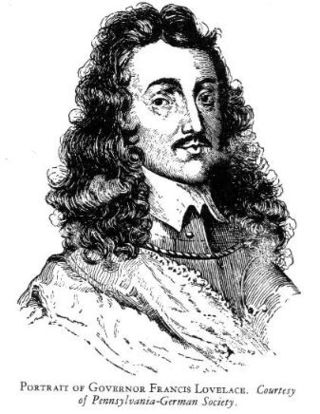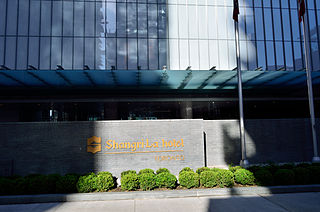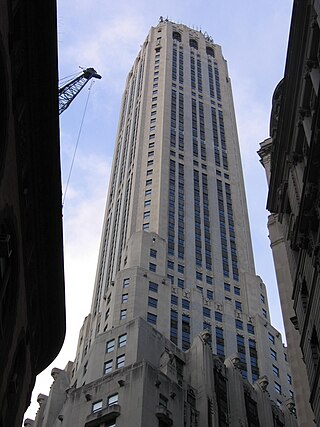
Francis Lovelace was an English Royalist and the second Governor of New York colony.

The New York City Landmarks Preservation Commission (LPC) is the New York City agency charged with administering the city's Landmarks Preservation Law. The LPC is responsible for protecting New York City's architecturally, historically, and culturally significant buildings and sites by granting them landmark or historic district status, and regulating them after designation. It is the largest municipal preservation agency in the nation. As of July 1, 2020, the LPC has designated more than 37,800 landmark properties in all five boroughs. Most of these are concentrated in historic districts, although there are over a thousand individual landmarks, as well as numerous interior and scenic landmarks.

Fort Orange was the first permanent Dutch settlement in New Netherland; the present-day city of Albany, New York developed at this site. It was built in 1624 as a replacement for Fort Nassau, which had been built on nearby Castle Island and served as a trading post until 1617 or 1618, when it was abandoned due to frequent flooding. Both forts were named in honor of the Dutch House of Orange-Nassau. Due to a dispute between the Director-General of New Netherland and the patroonship of Rensselaerswyck regarding jurisdiction over the fort and the surrounding community, the fort and community became an independent municipality, paving the way for the future city of Albany. After the English reconquered the region they soon abandoned Fort Orange in favor of a new fort: Fort Frederick, constructed in 1676.

Pearl Street is a street in the Financial District in Lower Manhattan, running northeast from Battery Park to the Brooklyn Bridge with an interruption at Fulton Street, where Pearl Street's alignment west of Fulton Street shifts one block south of its alignment east of Fulton Street, then turning west and terminating at Centre Street.

African Burial Ground National Monument is a monument at Duane Street and African Burial Ground Way in the Civic Center section of Lower Manhattan, New York City. Its main building is the Ted Weiss Federal Building at 290 Broadway. The site contains the remains of more than 419 Africans buried during the late 17th and 18th centuries in a portion of what was the largest colonial-era cemetery for people of African descent, some free, most enslaved. Historians estimate there may have been as many as 10,000–20,000 burials in what was called the Negroes Burial Ground in the 18th century. The five to six acre site's excavation and study was called "the most important historic urban archaeological project in the United States." The Burial Ground site is New York's earliest known African-American cemetery; studies show an estimated 15,000 African American people were buried here.

Broad Street is a north–south street in the Financial District of Lower Manhattan in New York City. Originally the Broad Canal in New Amsterdam, it stretches from today's South Street to Wall Street.

17 State Street is a 42-story office building along State Street and Battery Park in the Financial District of Lower Manhattan in New York City. Completed in 1988, it was designed by Roy Gee for Emery Roth and Sons for developers William Kaufman Organization and JMB Realty. The building is shaped like a quarter round, with a curved glass facade facing New York Harbor. At ground level, large aluminum columns surround a lobby and elevator hall. Next to the lobby was a public exhibition space called "New York Unearthed", which was operated by the South Street Seaport Museum from 1990 to 2005. The building has a total floor area of 525,000 sq ft (48,800 m2); each story was designed for small tenants.

Albany City Hall is the seat of government of the city of Albany, New York, United States. It houses the office of the mayor, the Common Council chamber, the city and traffic courts, as well as other city services. The present building was designed by Henry Hobson Richardson in the Romanesque style and opened in 1883 at 24 Eagle Street, between Corning Place and Pine Street. It is a rectangular three-and-a-half-story building with a 202-foot-tall (62 m) tower at its southwest corner. The tower contains one of the few municipal carillons in the country, dedicated in 1927, with 49 bells.

One Hanover is a commercial building at 1 Hanover Square, on the southwestern edge of the square, in the Financial District of Lower Manhattan in New York City. It was the site of the United States' first cotton futures exchange, the New York Cotton Exchange.

Stone Street is a short street in the Financial District of Manhattan in New York City. It runs in two sections between Whitehall Street in the west and Hanover Square in the east. The street originally was one continuous roadway from Whitehall Street to Hanover Square, but the section between Broad Street and Coenties Alley was eliminated in 1980 to make way for the Goldman Sachs building at 85 Broad Street. The one-block-long western section between Whitehall and Broad Streets carries vehicular traffic, while the two-block-long eastern section between Coenties Alley and Hanover Square is a pedestrian zone.

Coenties Slip is a street in the Financial District of Manhattan in New York City. It runs southeast for two blocks in Lower Manhattan from Pearl Street to South Street. A walkway runs an additional block north from Pearl Street to Stone Street.

Shangri-La Toronto is a luxury hotel and residential condominium building in downtown Toronto, Ontario, Canada. It was designed by James K. M. Cheng and built by Westbank Projects Corp.; they also designed and built the Living Shangri-La in Vancouver. The building is 214 meters tall and is one of the fifteen tallest buildings in Toronto. The hotel component is run by Shangri-La Hotels and Resorts and has 202 guest rooms and suites. The condominium portion occupies the upper floors of the building and consists of 393 units. Excavation of the site started in 2008, and work on the parking garage began in early 2009.
Joannes Nevius or Joannes Neef was the third secretary of New Amsterdam under the Director-General of New Netherland. He became the first secretary of New York City under the English.

The Atlantic Garden was a beer garden and music hall established by William Kramer in 1858 at what is now 50 Bowery in the Chinatown neighborhood of Manhattan in New York City. It was next to the Bowery Theatre, on the site of the Bull's Head Tavern and the New York Hotel. The premises extended west to a secondary frontage on Elizabeth Street.

The Ted Weiss Federal Building, also known as the Foley Square Federal Building, is a 34-story United States Federal Building at 290 Broadway in the Civic Center neighborhood of Lower Manhattan in New York City. Opened in 1994, the building was developed by Linpro New York Realty and designed by Hellmuth Obata & Kassabaum (HOK), with Raquel Ramati Associates as the design consultant and Tishman Construction as the general contractor. The building is named for Ted Weiss (1927–1992), a U.S. representative from New York.

State Street is a short street in the Financial District of Manhattan, New York City. It runs west from Whitehall Street as a continuation of Water Street, then turns north at Battery Park to become its eastern border. Passing Pearl and Bridge Streets, it terminates at the northeast corner of the park, at Bowling Green, where the roadway continues north as Broadway and west as Battery Place.
Walewyn (Walewijn) van der Veen, was born in 1617 and died sometime after 1679 in New York. He was one of the first lawyers and Notary Publics in New Amsterdam 1662–1664. The Register of New Netherland 1626-1674 by E.B. O Callaghan LL.D, Page 123. He succeeded the lawyer Salomon LaChaire 1661–1662. In 1664 New Amsterdam came under English rule and the named changed to New York. Walewijn van der Veen petitioned the provincial council for admission as Notary Public on October 27, 1661, and was officially sworn in on January 19, 1662. His workplace was in the old Town Hall or Stadt Huys built in 1642. The building was situated in Manhattan, on the corner of Pearl Street and Coenties Alley.

Exchange Place is a street in the Financial District of Lower Manhattan, New York City. The street runs five blocks between Trinity Place in the west and Hanover Street in the east.
250 Water Street is a site in the Financial District of Lower Manhattan in New York City. Most recently occupied by a parking lot, the site is being developed into a mixed-use building by the Howard Hughes Corporation. The site is located in the South Street Seaport, one of the city's historic districts.
















